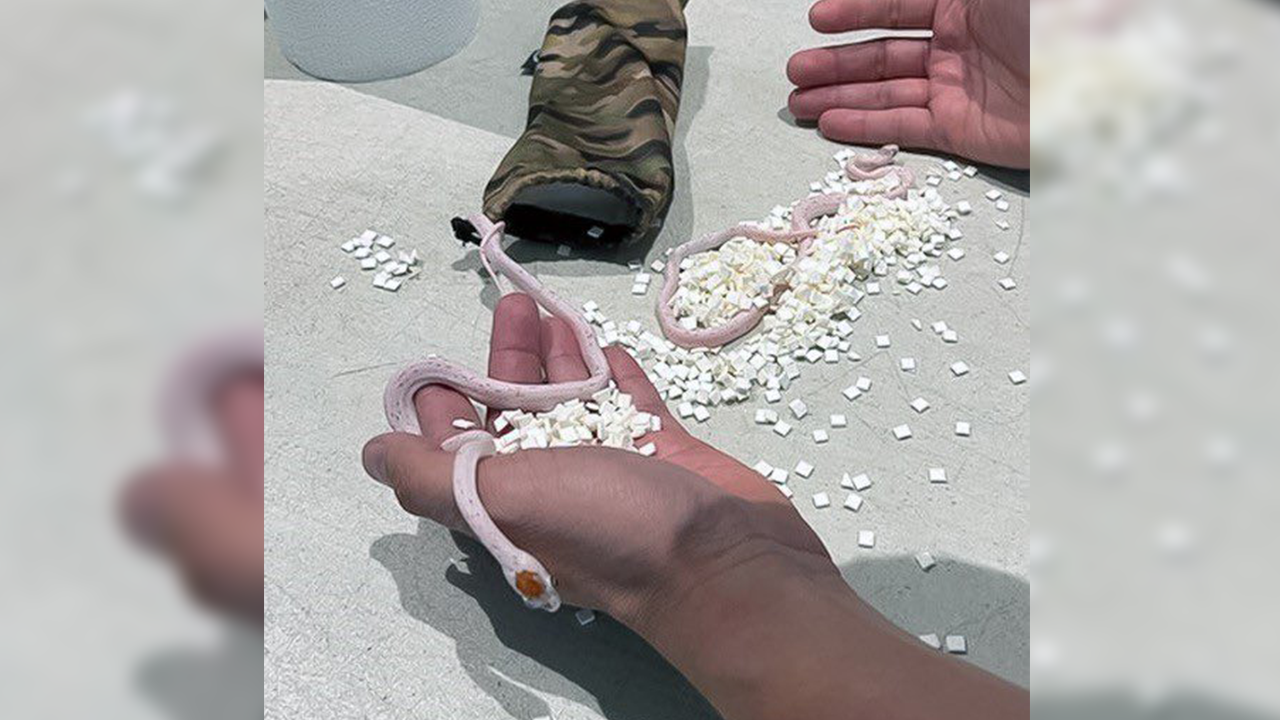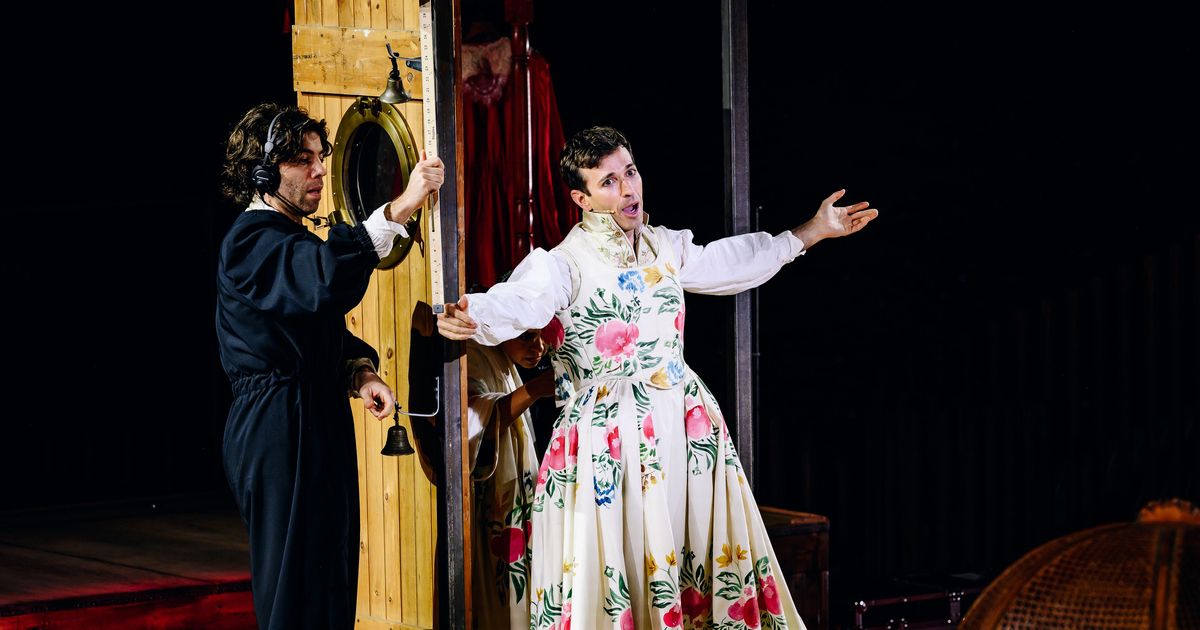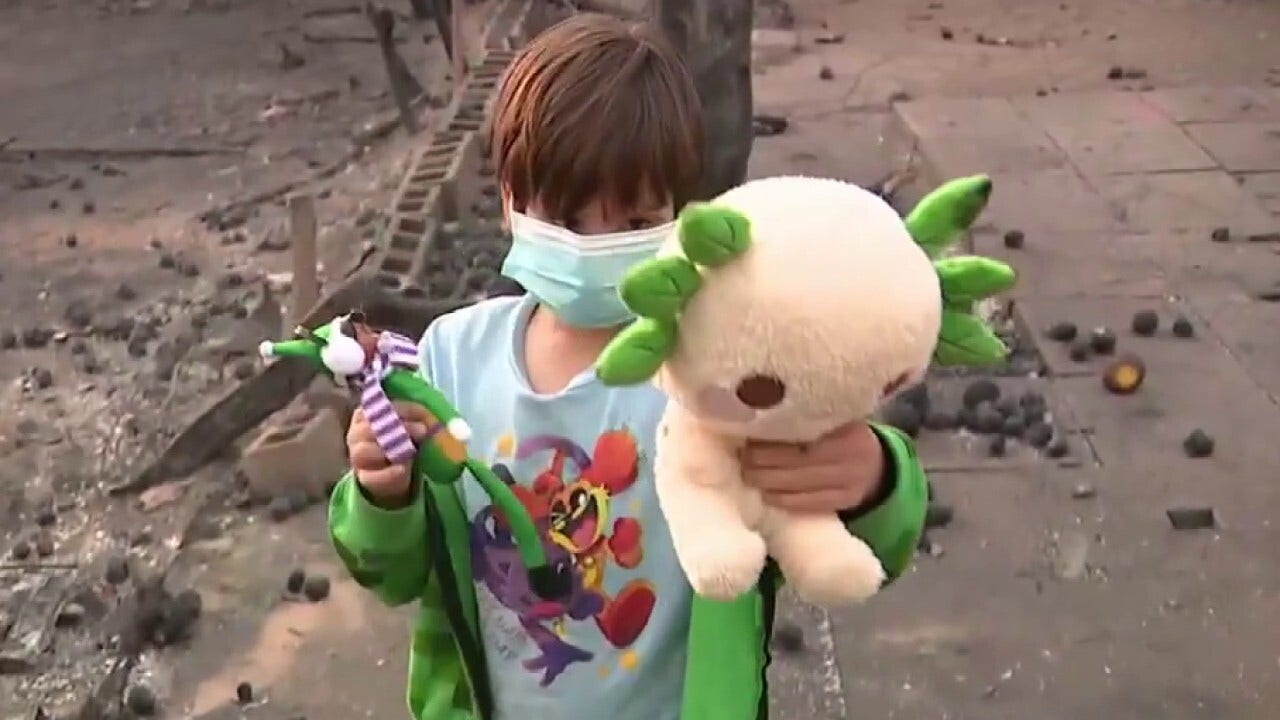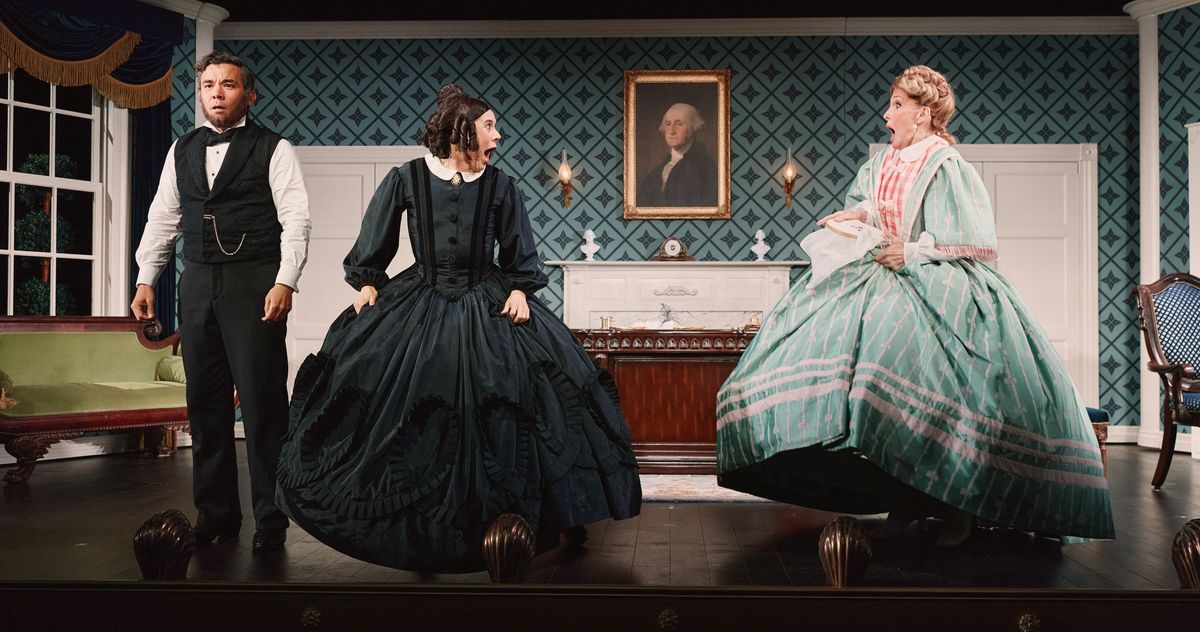Christopher Bannow and Anthony Roth Costanzo in The Marriage of Figaro.
Photo: Nina Westervelt
The night breeze was delicious in that late summer way, the lights of Jersey twinkled across the Hudson, and the countertenor Anthony Roth Costanzo’s vocal cords were projected live on two giant screens, pink and weird and undulating like some beast from the Aliens franchise, as he sang Countess Rosina’s Act Three aria, “Dove sono i bei momenti.” The image made my jaw drop, though perhaps not as much as Costanzo’s — there it loomed, a kind of weird, fleshy synecdoche for all of the frenetically ingenious reimagining of The Marriage of Figaro that’s currently bursting the seams of the outdoor amphitheater at Little Island. Like the production as a whole—which (full disclosure) I saw in a preview rather than at the opening night for critics, and (even fuller disclosure) whose creative team includes several people I know—the moment is both exposed and audacious, at once totally naked and flamboyantly theatrical. It’s a “watch this” flourish in a show that’s full of them. Indeed, this Figaro’s sleeves are so stuffed with tricks it sometimes feels like it’s in an arms race with itself — and, at the same time, the physical truth of the gesture is a wonder. Here on display is the paradox of opera: As a form, it could hardly be more absurd, more flagrantly artificial, and yet the whole precarious, glittering edifice rests atop a real miracle of the human body. If we are sad for the countess, it’s because we stand in awe of the larynx.
Now, take that awe—however much of it you’d spend on nine or so major characters—and stuff it into one body. Costanzo, who recently took over Opera Philadelphia and who seems to pop up almost any time something rad is happening in the opera world, sings every role in this Figaro himself. The show is his baby, gestated with the dramaturg Jacob Mallinson Bird and delivered with mad-scientist zeal by the inexhaustible director Dustin Wills. Rounding out the brain trust is musical director Dan Schlosberg, who helps to bring the whole thing in under 90 minutes by brilliantly slimming down the arrangement for an eight-piece orchestra, which he conducts with ferocity and precision from behind the keyboard. Virtuosity abounds — and extends into the ensemble. For Costanzo isn’t alone onstage; he’s surrounded by a company of actors, all first-rate clowns, who begin the play as his harried, breathless stagehands and gradually morph into full expressions of Mozart and Da Ponte’s characters. Costanzo may be the Kathy Seldon to their Lina Lamonts, but they’re nobody’s puppets. Their bodies—and, ultimately, their own voices—are just as crucial to the project as his. This breadth and depth of creative vitality is what keeps the core concept from feeling like a party trick. We’re not just here for a showcase by Costanzo, but to witness something more like a circus — the wild, symbiotic, you-catch-me I’ll-catch-you frisson of a trapeze act.
That kind of high-stakes, all-hands agility is really what farce requires. Figaro’s careering upstairs-downstairs shenanigans—derived from the deceptively fizzy 1778 play by Pierre Beaumarchais—are also well suited to Wills as a high priest of the church of More Is More. You might think at first that all there is to the show’s set (co-designed by Wills and Lisa Laratta) is its elegant wooden deck and its view of the Hudson, but it’s practically a pop-up book. Trap doors and rollaway sections of floor reveal lights, curtains, furniture, instruments, and people. Ryan Shinji Murray, embodying the drunken gardener Antonio, lip-syncs the majority of his part while doing flips on a previously hidden trampoline. Every climax one-ups itself; every metatheatrical break breaks again. Though I sometimes wished for a more rigorous edit—especially after Costanzo single-voicedly pulls off the opera’s insane Act Two finale and a break has to be built into the show for him—it would be simple petulance to resent a director with 50 ideas to spare when plenty struggle to have just one. This Figaro’s muchness is, more than anything else, ecstatically playful.
Such a breakneck, everything-and-the-kitchen-sink approach requires a confident handshake, and Wills, Costanzo, and company immediately define the terms: Here comes the countertenor—slight and muscular, with a face somehow both chiseled and elastic—wrestling a rolling costume rack up a ramp and onto the stage with the help of actor Emma Ramos, who wears a stage manager’s headset and a Buster Keaton–ish expression of deadpan haplessness. A spotlight catches Costanzo like a burglar in an old movie. Ramos shoves a yardstick in his hand and a tricorn on his head. Poof, he’s the affable, wily manservant Figaro, busy measuring out the space for his wedding bed. But all it takes for him to become his own fiancée, the clever maid Susanna, is for a rolling door to rotate and for him to sing through a window in its center, while a dress rigged up below the window (and a gazelle’s leap into the treble clef) alert us to his new identity. Then, poof again — a clownish red onesie with a lace collar conjures Cherubino, the adorably sex-crazed serving boy who’s usually played by a female mezzo. (This is where Costanzo’s voice and persona most naturally sit, and indeed, the seeds were planted for this Figaro long ago, when he first played Cherubino at 17.) Fleet, irreverent subtitles by Nicholas Betson and witty, rehearsal-style costume pieces by Emily Bode—a hat and waistcoat here, an open-back dress, a flower crown and ribbon there—keep us up to speed and entertained on multiple levels: Costanzo’s body-hopping experiment, after all, is layered on top of a play that already revels in disguise, swapped outfits, and mistaken identity. But in all the chaos, there’s no confusion. Wills is the kind of man behind the curtain who wants you to pay attention to the strings and levers. We follow, and we take delight, because the magician reveals the trick and trusts the revelation to generate the real magic.
Or magicians, I should say. Along with Murray and Ramos, actors Christopher Bannow, Ariana Venturi, and Daniel Liu, all gifted comedians, also become conjurers as the play goes along. In a parallel to Figaro’s own smiling subversiveness (the original play “caused the French Revolution,” Liu quips at one point, “because the servants had opinions or something”), the production’s corps of non-singers eventually ditch their headsets for costumes and opinions of their own. No longer will they run behind Costanzo, moving furniture and catching discarded props — now they’ll go toe to toe with him, even as he ventriloquizes for them. The results can be hilarious, as when Costanzo’s lower register pours out of Venturi, who swaggers and stamps her way across the stage as the lascivious Count Almaviva, a femme form joyously channeling ridiculous machismo. They can also be astonishingly poignant: Sad-eyed and tender in a golden gown, Liu’s Countess twice prompts a gorgeous ritardando in the production’s madcap tempo simply by sitting still and embodying the heartache of Costanzo’s mezzo. Both “Porgi amor” and “Dove sono” become fully hers, the Countess’s, and his, Liu’s, even as we stare down Costanzo’s trachea during the latter. There’s a delicate act of transference happening, a gift being given, and given doubly. If Liu is a conduit, so too, in some ineffable sense, is Costanzo. The fact that the music travels through an extra body on its way to us heightens our awareness of the miracle of its emergence in the first place.
The Marriage of Figaro is at Little Island through September 22.












